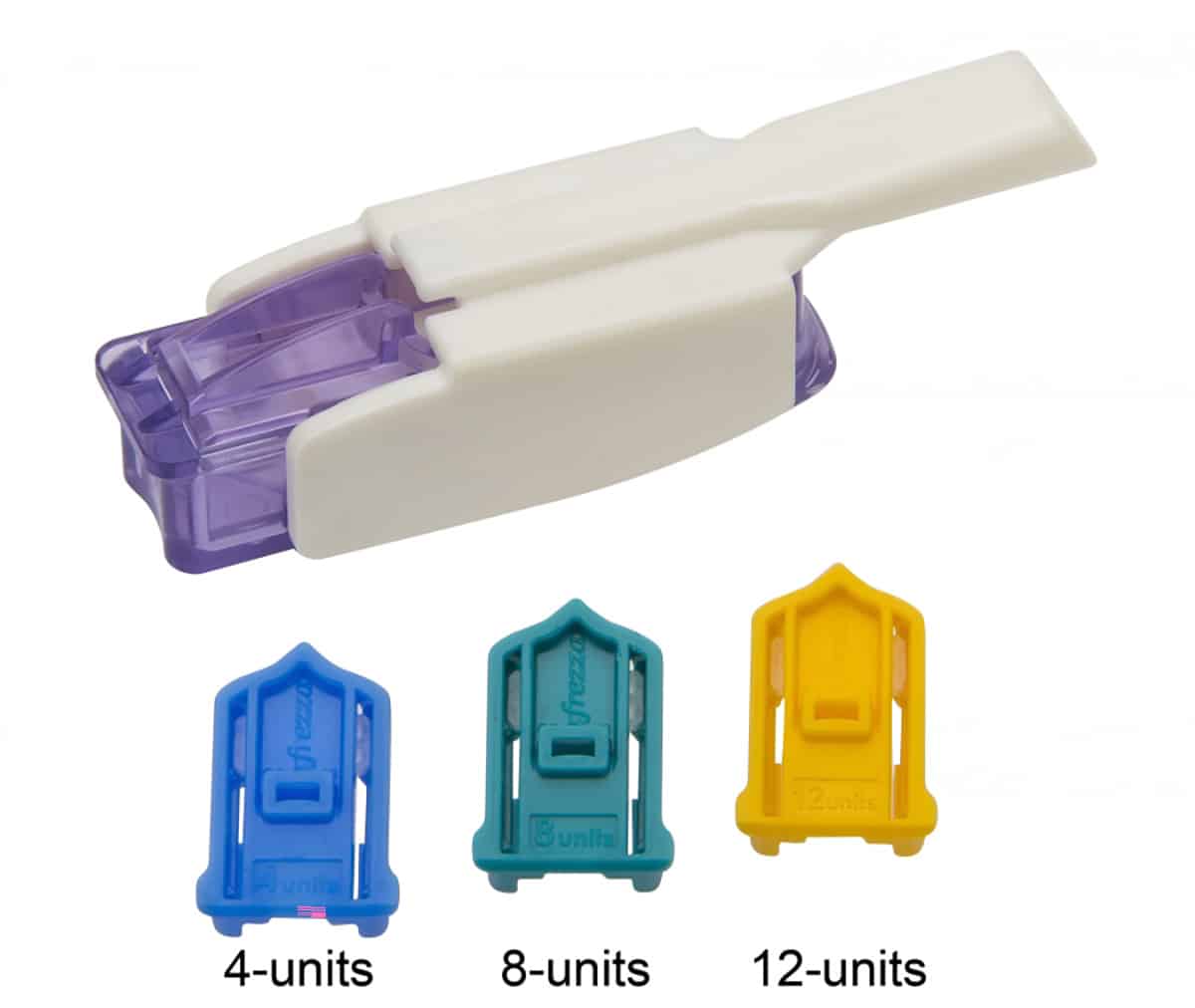Did you know that inhaled insulin is commercially available in the US and has been since 2014?! It’s probably one of the best-kept secrets in the diabetes community which, in my opinion, is a shame.
Afrezza has been a part of my diabetes toolbox for a few years now and in this article, I’ll give you an overview of what inhaled insulin is, how it works, and why I have chosen to use it.
What is Afrezza and how is it different from other rapid-acting insulins
Afrezza is a rapid-acting insulin similar to the rapid-acting insulins you inject (Apidra, Humalog or Novolog), but you inhale it rather than inject it. Just like the other rapid-acting insulins, it’s a mealtime insulin (bolus) so you still need another background insulin in the form of long-acting insulin (basal).
Inhaled insulin passes through the lungs and directly into the bloodstream, which means that the insulin starts to work significantly faster than injected insulin. It’s so fast that it will appear in the bloodstream within a minute of being inhaled and you can see the first measurable effect in about 12 minutes.
Because it works so quickly, it only stays in the body for about 90 minutes versus the 3-5 hours that injected rapid-acting insulin stays in the body.
Dosing Afrezza
Another way Afrezza is different from injected rapid-acting insulin is that it comes in set doses of 4, 8, and 12 units. When you receive your Afrezza from the pharmacy, it comes with a set of inhalers and you then pick the dose cartridge, load the inhaler, and inhale the whole dose.


The Afrezza units are not the same as the units for injected insulin. One unit of injected rapid-acting insulin is the same as about 1.5 units of Afrezza, which means that the smallest Afrezza cartridge (4 units) equals about 2.6 units of injected rapid-acting insulin.
Potential side effects
Afrezza has the same potential side effects as injected insulin but should not be used by people with certain lung problems, such as COPD or asthma, or people who currently smoke or have stopped smoking in the last 6 months.
You can read more about the potential side effects here.
I haven’t experienced any persistent coughing from using the product, but studies show that 27% of people reported developing a cough from using Afrezza.
Why I use inhaled insulin
I have used Afrezza for years alongside my basal insulin and injected rapid-acting insulin, and I find that it’s brilliant for certain situations.
I predominantly use Afrezza for resistant high blood sugars and higher-carb meals. We all know those situations where our blood sugar is “stuck” at a high level and it seems that no matter what we do, it won’t come down. Afrezza is a great solution for that.
If I’m stuck at 200 mg/dl (~11 mmol/l) or above, I’ll reach for a 4-unit Afrezza cartridge and my blood sugar will get down into range VERY quickly. A 4-unit cartridge drops me about 100 mg/dl (5.6 mmol/L) but how much it will decrease your blood sugar depends on your correction factor.
Note: I found that Afrezza would decrease my blood sugar a little more aggressively the first month or so after I started using it. I have heard the same from other users, but it’s only anecdotal information at this point since I haven’t seen any data to support it.
Another situation where I really appreciate having access to Afrezza is when I enjoy a higher-carb meal or a high glycemic meal. Since Afrezza hits the bloodstream so quickly, I don’t have to pre-bolus for the carbs, and I find it easier to match the peak of Afrezza to the food than I do with injected rapid-acting insulin.
How it interacts with exercise
I wanted to use Afrezza when I eat before doing cardio since it’s out of the body in 90-minutes (remember, having rapid-acting insulin active in the body during cardio will increase the risk of low blood sugar). Unfortunately, the fact that Afrezza only comes in fixed doses means that I rarely have access to the right dose and I have to stick with injected insulin.
Another observation I’ve made is that the effect of Afrezza seems to get intensified even more by exercise than regular rapid-acting insulin. This means that I am very careful if I have to do any type of exercise within a 90-minute window of inhaling Afrezza.
One of the first times I used Afrezza was to bring down a high blood sugar just before biking home from having brunch. It made my blood sugar drop much more than I expected and I had to stop after less than 10 minutes on the bike to treat a significantly low blood sugar.
Learning to use a new insulin
Learning how to use Afrezza is a bit like learning a new language, and just as we don’t always get the doses right for injected insulin, you won’t get the dosing/timing right every time for Afrezza either.
It takes time and some trial-and-error to figure out how much Afrezza to take, when to take it, and when NOT to take it.
And for full disclosure, I’ve had some of the scariest low blood sugars of my life using Afrezza. Because Afrezza is so effective, having too much on board can quickly decrease blood sugars significantly. What I’m trying to say is that this is NOT the insulin that you “rage bolus” with.
There are upsides and downsides to using Afrezza and I still recommend using it in the way that’s right for you.
Aside from the occasional lows and limited unit sizes, I think it’s a brilliant product. It really is a very effective way of lowering blood sugars quickly
How to get Afrezza
Afrezza was approved by the FDA in 2014 and is currently only available in the United States and a few other countries. If you live in the United States, your doctor can prescribe Afrezza just as he/she can prescribe any other kind of insulin.
Your doctor might not know about Afrezza and if that’s the case, you’ll need to educate and push for a prescription. If you don’t feel comfortable having that conversation, you can always refer your doctor to the Afrezza website.
Before prescribing Afrezza, your doctor should do an FEV (forced expiratory volume) breathing test to gain an understanding of your lung function. It’s a pretty simple test, you just need to breathe into a mouthpiece. Your doctor should then have you perform the test again after 6 months and every year after that to ensure there’s no change to your lung function.
Once you have your prescription, you’ll pick up Afrezza at the pharmacy just like you do with any of your other insulins.
If you have private insurance, Afrezza is most likely covered since it’s available on 70% of private insurance plans. It might be an idea to call your insurance company or read up on your benefits plan to learn if you’re covered and what your co-pay is. Most people pay about $45 out-of-pocket per prescription, but that will, of course, vary by plan.
I’d highly recommend using the Afrezza co-pay card. For me, it means that my co-pay gets reduced to $15 per prescription, which makes Afrezza a very affordable insulin option.

